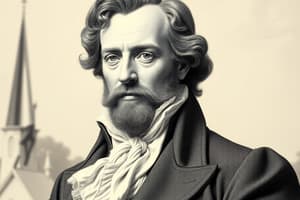Podcast
Questions and Answers
In Frédéric Sorrieu's vision of a utopian world, which country is identified by the revolutionary tricolor?
In Frédéric Sorrieu's vision of a utopian world, which country is identified by the revolutionary tricolor?
- France (correct)
- Germany
- Switzerland
- United States
What does the statue of Liberty in Sorrieu's print hold in her hands?
What does the statue of Liberty in Sorrieu's print hold in her hands?
- A crown and a scepter
- The Charter of the Rights of Man and a torch (correct)
- A book and a pen
- A sword and a shield
Which country leads the procession way past the statue of Liberty in Sorrieu's print?
Which country leads the procession way past the statue of Liberty in Sorrieu's print?
- Germany
- France
- Switzerland
- United States (correct)
What was the expression of liberal hopes in 1848 regarding the German-speaking principalities?
What was the expression of liberal hopes in 1848 regarding the German-speaking principalities?
What is the main focus of nationalism in nineteenth-century Europe, as mentioned in the text?
What is the main focus of nationalism in nineteenth-century Europe, as mentioned in the text?
Which group came to develop a sense of common identity and shared history in a nation-state?
Which group came to develop a sense of common identity and shared history in a nation-state?
What was used by the artist in Fig. 1 to symbolize fraternity among the nations of the world?
What was used by the artist in Fig. 1 to symbolize fraternity among the nations of the world?
What historical force brought about sweeping changes in the political and mental world of Europe during the nineteenth century?
What historical force brought about sweeping changes in the political and mental world of Europe during the nineteenth century?
What do the shattered remains of the symbols of absolutist institutions in Sorrieu's print symbolize?
What do the shattered remains of the symbols of absolutist institutions in Sorrieu's print symbolize?
Which nation, not yet a united nation-state, is represented in Sorrieu's print by bearing a flag expressing liberal hopes in 1848?
Which nation, not yet a united nation-state, is represented in Sorrieu's print by bearing a flag expressing liberal hopes in 1848?
What does the procession in Sorrieu's print suggest about the artist's vision of the world?
What does the procession in Sorrieu's print suggest about the artist's vision of the world?
Which two countries are leading the procession way past the statue of Liberty in Sorrieu's print?
Which two countries are leading the procession way past the statue of Liberty in Sorrieu's print?
What historical force led to the emergence of the nation-state in nineteenth-century Europe?
What historical force led to the emergence of the nation-state in nineteenth-century Europe?
What distinguished a nation-state from a modern state, according to the text?
What distinguished a nation-state from a modern state, according to the text?
What did the Christ, saints, and angels symbolize in Sorrieu's art piece?
What did the Christ, saints, and angels symbolize in Sorrieu's art piece?
What brought about diverse processes through which nation-states and nationalism emerged in nineteenth-century Europe?
What brought about diverse processes through which nation-states and nationalism emerged in nineteenth-century Europe?
Flashcards are hidden until you start studying
Study Notes
Frédéric Sorrieu's Vision of a Utopian World
- France is identified by the revolutionary tricolor in Sorrieu's vision.
- The statue of Liberty in Sorrieu's print holds a torch and a tablet inscribed with the Declaration of the Rights of Man.
Nationalism in Nineteenth-Century Europe
- The main focus of nationalism is the creation of a unified nation-state.
- The group that came to develop a sense of common identity and shared history is the people of a nation-state.
Symbolism in Sorrieu's Print
- The shattered remains of the symbols of absolutist institutions symbolize the end of absolute monarchy and tyranny.
- The procession in Sorrieu's print suggests a world united under the principles of liberty, equality, and fraternity.
Leading the Procession
- The two countries leading the procession way past the statue of Liberty in Sorrieu's print are Germany and Italy, which were not yet united nation-states.
Historical Forces
- The historical force that brought about sweeping changes in the political and mental world of Europe during the nineteenth century is nationalism.
- The historical force that led to the emergence of the nation-state in nineteenth-century Europe is the liberal and democratic ideals.
Nation-State vs Modern State
- A nation-state is distinguished from a modern state by its emphasis on a shared identity, history, and culture.
Artistic Symbolism
- The Christ, saints, and angels in Sorrieu's art piece symbolize the ideal of a world united in peace and harmony.
Diverse Processes
- The diverse processes that brought about the emergence of nation-states and nationalism in nineteenth-century Europe include the unification of Italy and Germany under liberal and democratic ideals.
Studying That Suits You
Use AI to generate personalized quizzes and flashcards to suit your learning preferences.




